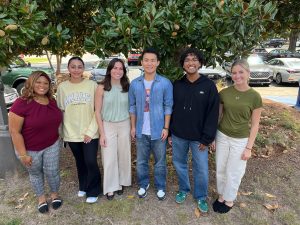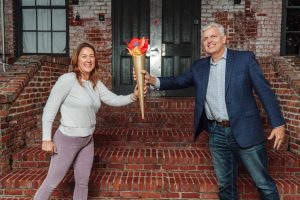Strategic Partner Spotlight: Smith Anderson

In this week’s spotlight, we interviewed Jason Brege, partner and co-lead of both the AgTech and Technology practice groups at one of CED’s strategic partner law firms, Smith Anderson. In this and upcoming spotlight features, we will be branching out from descriptions of our strategic partners to learn more about the individuals, the personalities, and the contributions that they make to our local entrepreneurial ecosystem. Read more to learn how Jason pivoted a science background into a successful career as a technology lawyer at Smith Anderson, where he has led billions of dollars’ worth of pharmaceutical development collaborations, helps lead one of the country’s leading AgTech law practices, and learned key lessons about lawyering from the art of flying fighter jets…
In your words, can you give me a brief overview of your professional career?

I backed into my career in law. I was a science major in undergrad studying pre-med. I majored in Physics and Math with a minor in English, thinking I was going to med school until I unexpectedly lost interest in medicine. Somehow, I stumbled into a law school information session and they asked what we thought the number one major was, percentage-wise, for getting into law school. Everyone said, “English, PoliSci, History” – the usual pre-law studies. But it turns out that the number one major at the time was Physics and the number two major was Math. Law schools have figured out that people with that background have a very rigorous and organized way of thinking, which happens to align really well with how you think about the law and how you think about structuring deals as a lawyer.
My love of technology has translated into how my career as a lawyer has evolved. I went to UVA for law school, then came down to North Carolina and have been at Smith Anderson for the last 12 years. I started working with technology companies at the very beginning; in particular, I realized I could use my love of technology and my understanding of science to help clients make money on their innovations. With my background, I am able to understand enough of the science and technology behind what the client is doing to help them figure out ways to partner with other companies and how to collaborate to make something together that they could not make on their own. That collaboration is super exciting for me and I love helping my clients succeed.
Can you tell us more about your role as the co-leader of AgTech and Technology practices at Smith Anderson?
Our AgTech team is one of our fastest growing practices within Smith Anderson, with a reach much broader than the Triangle, servicing over 50 AgTech companies, with headquarters in 11 other states and 7 foreign countries. Our Technology team is also one of the leading practice areas within the firm, hiring three lawyers with a collective 50+ years of experience within the past year, in addition to entry-level lawyers. As a co-leader of each of these practices, I help set the strategic direction and help coordinate the development of our lawyers. For example, we want to be sure that our lawyers know what AgTech companies are doing, what their objectives are, and how they go about their business. So we want to make sure that we are educating our lawyers on the industry; both how we do the legal work and how we train and develop a team that can serve the needs of our clients in that industry. The same process applies with respect to Smith Anderson’s technology practice, which includes pharmaceuticals/biotechnology, high technology, and software. Our clients range from the growth companies that CED works with to large public companies. We have to be able to provide legal work for all of them, so a lot of my role involves internal development of our team. At Smith Anderson, we want to be the best lawyers we can be for our clients, which requires an intentional approach.
The other part of my role is making sure we are identifying and working with clients in the RTP area as well as nationally and internationally that need sophisticated legal assistance. We want to continue to grow Smith Anderson’s profile both within the Triangle and beyond.
What factors make the Triangle a good place to start or grow an AgTech company?
The Triangle is one of the top two or three hubs for agricultural technology research in the entire world. In the United States it’s RTP, St. Louis, and the area around Sacramento and UC Davis. We have a huge critical mass of agricultural innovation here. In the big picture, everyone is trying to make sure we can feed the world’s future population. We have to nearly double food production on more limited resources in the next 20-30 years, so everyone in the AgTech industry is working towards that goal.
Here in RTP, we have big companies with huge operations like BASF, Syngenta, and Bayer. Then we have midsize companies like Novozymes, Verdesian, and a number of ag-chemical companies. And we have a huge critical mass of high-growth venture-backed companies like AgBiome, Elo Life Systems, Pairwise, PlantResponse and most recently, Vestaron. These types of companies are relocating from elsewhere to the Triangle to take advantage of the critical mass of companies that are already here and the talent that works for those companies. This hotbed is very talent driven, where even though a few jobs may leave with mergers or acquisitions, many people who would have left prefer to stay here to join an existing team at another company or start their own entrepreneurial AgTech company. The world of entrepreneurship and innovation benefits greatly when you have innovators that move around and are able to create new growth companies.
Why is it important for Smith Anderson to engage with the entrepreneurial community in the Triangle?
We are rooted here and in all of our 100+ years of existence as a law firm, Smith Anderson has had a culture of caring about and engaging in the community. Whether that is demonstrated through serving on the board of a company or non-profit, service for the Bar Association or other community service, we care about having deep roots where we are. It is part of our professional responsibility as lawyers to be involved in more than just being lawyers doing legal work.
Smith Anderson’s involvement in the entrepreneurial community is consistent with that. We want to make sure that companies here in RTP grow. Our roots are here, we care about the long-term stability of RTP and we want to see companies succeed. When we have the legal experience and skillset to help them succeed, it benefits us both. We get better as these companies grow, and they get better as we leverage the experience we have and help them accomplish their goals.
What is your favorite part of your job?
I enjoy working with innovative companies to help develop and execute their strategy to collaborate with others. For me, that often looks like the whiteboard session where I am sitting in a room with the client structuring their approach to engaging with their partner companies or customers and drawing it out together. We are collectively assembling what it’s going to look like from a business standpoint, and then creating the legal structures and documents from those sessions. That’s a ton of fun because it involves flexing creative business muscles to ultimately feed into something that may be a “boring” legal document, but it is meaningful because it captures what our clients want to accomplish consistent with their business goals.
What is the biggest professional lesson you have learned in your career?
Early on in my career at Smith Anderson, I had two different lawyers describe a concept to me in slightly different ways.
One of them said that your “zone of competence” is bigger than your “zone of confidence.” Another colleague, who was in the Navy, shared a similar concept from fighter pilot training. He said that a fighter jet has an “envelope,” which is essentially the acceptable operating parameters and limits of your plane. So if you fly within the envelope, you’re going to stay in the air; if you go outside that envelope, you’ll likely fall to the ground and crash. As a fighter pilot, you have to learn to operate on the edge of that envelope. You grow by operating on that outer edge of comfort.
Operating on the edge of the envelope is how you grow and become a better attorney. It’s not about doing the same thing you did yesterday in the exact same way; it’s about pushing yourself. Growth as an attorney is about learning, it’s about getting out in front of that client and having that in-person meeting that feels uncomfortable because you’ve never done it. When you learn to do something, it becomes natural and that turns into a speaking engagement or a successful negotiation down the road because you are pushing yourself outside your comfort zone and operating at the edge of the envelope. Then you recognize you are in fact competent beyond where you used to feel your level of highest confidence.
What professional achievement are you most proud of so far in your career?
I am most proud of my role in a trio of pioneering deals in the human therapeutics gene editing space. Together, they account for over $3Bn in deal value in the areas of developing new cancer treatments, new antibacterial treatments and treatments for other infectious diseases. It’s really cool to be able to work on deals of that magnitude and that scope at Smith Anderson and see that they have a real impact for ultimately healing diseases and solving health problems.
What is your idea of a perfect weekend?
Escaping to the mountains with my wife and boys. I have a five year old son and an eight year old son. I love the backcountry, getting off the grid, fly fishing and camping. My wife prefers a book to the fly fishing, but enjoys the rest of it.
What’s your favorite restaurant in the Triangle?
I’m partial to restaurants in the Dos Taquitos, Gonza Tacos y Tequila, and Centro “family” of restaurants.
What’s the last thing you read that you enjoyed?
I somehow managed to never read the Harry Potter books over the years. A couple months ago my eight year old started to read them, so my wife and I blitzed through them in about two months.



